
Back Diddordeb dynol Welsh Human Interest German Minat insani ID ヒューマンインタレスト記事 Japanese Cerita pesona Malay Humaninterestjournalistiek Dutch Reportagem de interesse humano Portuguese Truyện nhân cảm Vietnamese 人性化故事 Chinese

In journalism, a human-interest story is a feature story that discusses people or pets in an emotional way.[1] It presents people and their problems, concerns, or achievements in a way that brings about interest, sympathy or motivation in the reader or viewer. Human-interest stories are a type of soft news.[2]
Human-interest stories may be "the story behind the story" about an event, organization, or otherwise faceless historical happening, such as about the life of an individual soldier during wartime, an interview with a survivor of a natural disaster, a random act of kindness, or profile of someone known for a career achievement. A study published in the American Behavioral Scientist illustrates that human-interest stories are furthermore often used in the news coverage of irregular immigration, although the frequency differs from country to country.[3] Human-interest features are frequently evergreen content, easily recorded well in advance and/or rerun during holidays or slow news days.
The popularity of the human-interest format derives from the stories' ability to put the consumer at the heart of a current event or personal story through making its content relatable to the viewer in order to draw their interest.[4] Human-interest stories also have the role of diverting consumers from "hard news" as they often are used to amuse consumers and leave them with a light-hearted story.
Human-interest stories are sometimes criticized as "soft" news, or manipulative,[1] sensationalistic programming. Human-interest stories have been labelled as fictitious news reporting, used in an attempt to make certain content appear relevant to the viewer or reader.[2] Human-interest stories are regarded by some scholars as a form of journalistic manipulation or propaganda, often published with the intention of boosting viewership ratings or attracting higher amounts of sales and revenue.[3] Major human-interest stories are presented with a view to entertain the readers or viewers while informing them. Terry Morris, an early proponent of the genre, said she took "considerable license with the facts that are given to me".[1]
The content of a human-interest story is not just limited to the reporting of one individual person, as they may feature a group of people, a specific culture, a pet or animal, a part of nature or an object. These reports may celebrate the successes of the person/topic in focus, or explore their troubles, hardships. The human-interest story is usually positive in nature, although they are also used to showcase opinions and concerns, as well sometimes being exposés or confrontational pieces.
- ^ a b c Miller, Laura (October 16, 2011). "'Sybil Exposed': Memory, lies and therapy". Salon. Salon Media Group. Retrieved October 17, 2011.
- ^ a b Hughes, Helen. (Ed.). (1980). News and the Human Interest Story. New York: Routledge.
- ^ a b Vanderwicken, Peter (1995). "Why the News is Not the Truth". Harvard Business Review.
- ^ Brooks, Andrew (2018). "The Power of the Human Interest Story". Zazzle Media.